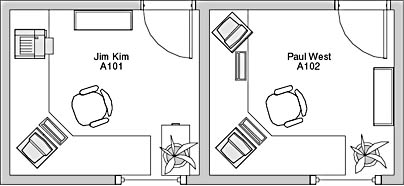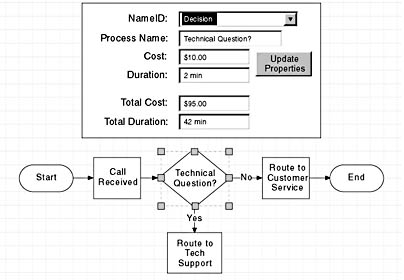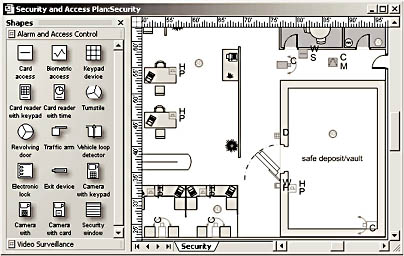About Visio Solutions
3 4
A Microsoft Visiosolution is a combination of Visio shapes and programs that model the real world and solve specific drawing problems. A Visio solution usually includes stencils of master shapes, called masters, that a user can drag and drop onto the drawing page to create a drawing, without having to draw anything manually. A solution might also include templates that provide stencils of specific shapes such as title boxes, logos, or frames for use in new drawings, and that predefine the drawing scale, drawing size, and occasionally the paper size for printing.
Programs (either VBA code within the solution's Visio documents or stand-alone programs external to Visio documents) can help create the drawing, analyze the drawing, or transfer information between the drawing and external data sources. Shapes can have online Help to assist a user in using them correctly.
Modeling with Visio Shapes
A model helps you analyze and solve a problem using objects that resemble things in the domain of the model, whether that's the organization of people in your department, the arrangement of desks and chairs in a floor plan, the network you're selling to a customer, or a state diagram for an integrated circuit. Because a model resembles the real world, you can design and develop a solution in terms that users understand.
In a well-designed Visio solution, shapes correspond to objects in the domain of the model. Creating the drawing constructs the model. Shape behavior encourages correct modeling and correct graphical representation, while allowing the user to override certain attributes to create a readable representation.
For example, if you're planning the organization of a department, the domain of the model is the department, and employees are objects in the domain. A drawing that represents this model would be a simple organization chart of boxes with connecting lines that show who reports to whom.

Figure 1-1 A user could reorganize a department by changing connections between employees.
Or, suppose you're creating a facilities plan to move your company to a new office building. The domain of the model is the building, and employees would be objects in this domain, but it would also include furniture, computing equipment, and so on. A drawing that represents this model would be an office layout diagram showing where each employee is located, and what furniture and equipment the employee has in an office.

Figure 1-2 A user could create a moving plan by dragging employee, furniture, and computer shapes.
You can design Visio shapes as reusable components so that your users can create drawings without having to use drawing tools. Visio is an excellent tool for modeling, because not only can shapes resemble objects in the model domain, they can be designed to encourage development of a correct model.
For example:
- A user might reorganize a department by moving the connections between employees in an organization chart. Shapes could be designed to encourage correct organizational design by having predefined connection points, showing the user where to place connections (and subtly discouraging impractical arrangements, such as having one employee report to two managers).
- A user might create a moving plan by dragging employee, furniture, and computer shapes in an office layout diagram. Shapes could be designed to encourage correct layout by having control handles a user could drag to check clearances of doors and drawers, and shapes might be locked against resizing so a user couldn't inadvertently resize standard furniture so that it wouldn't fit in a real office.
Extracting data from a model
A Visio drawing is usually just a partial view of a model, and rarely the end product. A Visio solution is most valuable when drawings represent a model that data can be automatically extracted from. For example, in a process modeling solution, the drawing shows the steps of a process, but you might also need to know the cost per transaction of each process.

Figure 1-3 Data extracted from a process drawing.
Sometimes you can add enough data to a Visio drawing so that the complete model is stored in the drawing, but if you have many drawings that have to be consistent, part of the model can reside in a single shared database, such as specifications for kitchen cabinets, counters, and appliances, or tables of process inputs and outputs.
Validating a model
Models also have rules that dictate how objects should behave. Drawings must follow certain rules to be readable—for example, an organization chart with overlapping connectors and boxes is less effective than one where boxes are consistently spaced and connectors route around them.
However, creating a drawing that looks correct is not enough—shapes must be designed, and the drawing must be made, so that data it represents can be checked for accuracy. For example, in a moving plan, every employee should have a desk; multiple employees would rarely share a desk, and one employee would rarely have more than one desk.
A Visio solution can analyze data extracted from drawings to make sure it follows the rules of the model. Suppose many departments are being changed in a companywide reorganization. The reporting structures expressed in separate departmental organization charts can be automatically extracted and their separate structures merged into a global organization structure to check for consistency. For example, the solution could ensure that no employee reports to more than one manager, any employee not appearing in the proposed reorganization is being intentionally removed from the organization, and so on.

Figure 1-4 A Visio solution can analyze drawings to validate the model.
Field Sales Automation: an Example of a Visio Solution
To see how a Visio solution can model the real world, extract data from the model, and validate it, consider as an example a field sales solution for a company that designs and sells security systems.
Traditionally, a salesperson calls on a potential customer to discuss security needs, designs a system by looking up components in a parts catalog (which might include current prices) and sketching the proposed system with pencil and paper. The salesperson possibly gives the customer a rough estimate of cost, and then returns to the office to prepare a formal proposal. Back at the office, the sketch is re-created in a drawing program, prices are looked up and totaled for the bid, and a proposal document is written. If the customer accepts the proposal, the company prepares a contract for the customer to sign and a work order for the installation.
The traditional approach works well, assuming everything goes as planned. But suppose the original sketch omits some essential components, connects them incorrectly, or leaves something unconnected. Suppose the formal drawing doesn't match the sketch. If the salesperson's catalog is out of date, the proposed system might include components that are unavailable or more expensive. Creating each document manually increases the possibility of error at every stage in the process, up to and including installation at the customer site. Even if all goes well, at each stage it takes time to prepare each document, check for errors, and correct them.
Here's how a Visio solution can automate this process: The salesperson, carrying a laptop with Visio and the sales automation solution installed, calls on a potential customer. As they discuss security needs, the salesperson diagrams the proposed system by dragging shapes from a custom stencil to their correct locations in a Visio drawing of the installation site. The security system shapes are designed with connection points and control handles that make it easy for the salesperson to arrange them correctly, and the stencil is updated regularly so the salesperson doesn't have to worry about obsolete components.

Figure 1-5 A security system designed with a Visio solution.
The security system shapes have custom properties that store data such as part numbers, and the solution includes a database of current prices and other detailed information about components, along with programs that can synchronize the shapes with the database. This allows the salesperson to do the following:
- Validate the proposed security system by checking the drawing to ensure that all components are correctly placed and connected, so the salesperson can correct errors before leaving the customer site.
- Look up current prices in the database to generate a bill of materials and an accurate estimate for the bid, so the customer knows what the cost will be.
Either in the field or back at the office, the Visio solution could generate the proposal, contract, installation work order, and invoice, all based on the salesperson's original drawing. The Visio solution creates more accurate documents in less time, freeing the salesperson to work with more customers.
EAN: 2147483647
Pages: 180